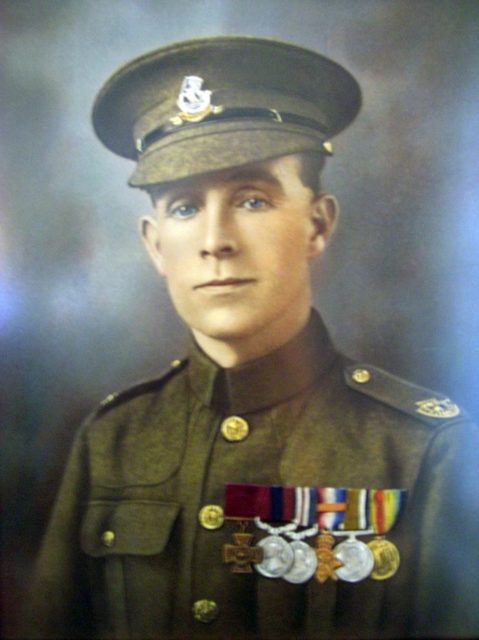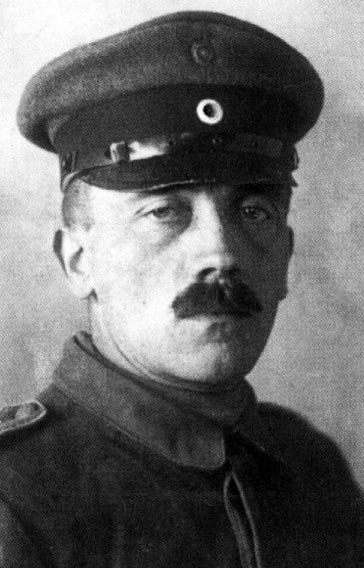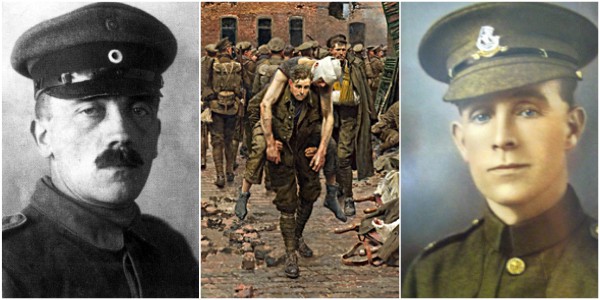The military code of conduct changes over time. During WWI, one would expect that despite the horrifying circumstances, wounded enemies should not be shot down like clay pigeons. Nevertheless, that is exactly what had happened most of the time. Private Henry Tandey thought otherwise.
Henry Tandey was born into a military family in 1891. On 12 August 1910, he joined the Green Howards line infantry regiment of the British Army. Prior to the outbreak of WWI, he was posted in Guernsey and South Africa.
His achievements made him the single most decorated private soldier in WWI. In October 1914, he took part in the battle of Ypres in Belgium, where the British forces suffered great casualties from the German enemy.
The ending scene with Tandey carrying a soldier wounded in this battle with no clear outcome was later depicted by an Italian artist, Fortunino Matania. Years later, this picture will be in the spotlight of an international controversy that will haunt Tandey for the rest of his life.
Two years later, in August 1916, he fought in France, in the Second Battle of Cambrai during the Hundred Days Offensive. His resoluteness in storming across the no man’s land in order to bomb the German trenches and the subsequent capturing of 20 prisoners earned him the Distinguished Conduct Medal. Two weeks later, he repeated the scenario, returning with a bunch of prisoners yet again. This earned him the Military Medal.
As the war was coming to an end, on 28 September 1918 in Marconing, France, under heavy MG fire, he single-handedly repaired a bridge for his comrades to cross, and later during the day led a bayonet charge against the far more numerous German troops, chasing 37 of them right into the hands of his comrades.
For this conspicuous act, the British Army gave him the highest medal of all – the Victoria Cross. But that is not the end. At one point, Tandey spotted a wounded German soldier. Tandey lowered his rifle and let him retreat into the distance. The German soldier gave him a nod of thankful approval.

Throughout those years, this outstanding soldier, five times Mentioned in Dispatches and decorated personally by King George V, kept a secret he himself was unaware of.
Fast forward to 1938. Germans are already preparing for another war, and Hitler’s regime is brutally repressing his opposition.
In a last effort to prevent the outbreak of another human tragedy, Neville Chamberlain, then British Prime Minister, paid a visit to Hitler in his Bavarian retreat. Wandering through the mansion, one picture attracted Chamberlain’s attention. It was Matania’s depiction of British soldiers retreating through the Ypres village.
Surprised, he asked Hitler why he would hang a picture of enemy soldiers whom he fought against in WWI. Hitler pointed at the soldier carrying a wounded comrade and replied that ‘that man came so near to killing me that I thought I should never see Germany again, providence saved me from such devilishly accurate fire as those English boys were aiming at us.’ He said it was in 1918, during the Battle of Marconing. Then he asked the British PM to pass on his gratitude to Pte Tandey.

Henry Tandey never recalled the incident, even though he did tell the journalists on one occasion that he deliberately used to let the wounded enemies flee the scene.
The destruction of the records makes it hard to locate Hitler’s whereabouts in 1918, but it is known for sure that four years earlier he did take part in the Battle of Ypres and got injured. Therefore, Hitler either mixed up the dates and places, or he simply wanted to have a reminder of a man who spared his life.
As you’d probably guess, the man himself was not so satisfied with finding out about his unexpected role in history. Aged 49, he unsuccessfully reapplied to service, claiming that Hitler won’t escape his bullet for the second time. Henry Tandey died in 1978 and was buried in the historical site that marked his life forever – the French commune of Marconing.
